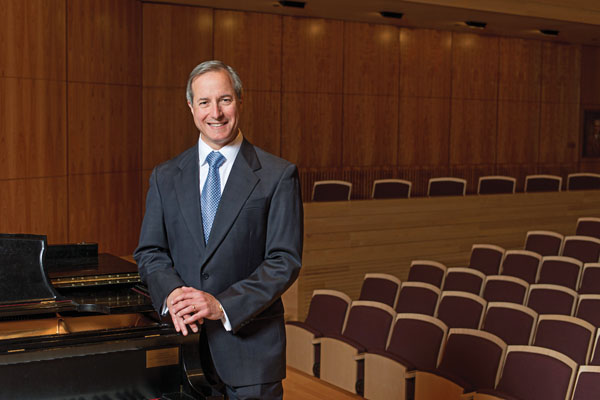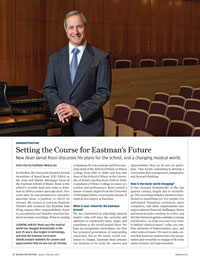In Review
 LOOKING AHEAD: Rossi says the musical world has changed dramatically in the past 25 years, due largely to technology, and
that the Eastman curriculum should prepare students for careers and opportunities that no one can yet foresee. (Photo: Brandon Vick)
LOOKING AHEAD: Rossi says the musical world has changed dramatically in the past 25 years, due largely to technology, and
that the Eastman curriculum should prepare students for careers and opportunities that no one can yet foresee. (Photo: Brandon Vick)In October, the University hosted a formal investiture of Jamal Rossi ’87E (DMA) as the Joan and Martin Messinger Dean of the Eastman School of Music. Rossi is the school’s seventh dean and came to Eastman in 2005 as senior associate dean. Two years later, he was promoted to executive associate dean—a position in which he oversaw the project to renovate Eastman Theatre and construct the Eastman East Wing, among other responsibilities. Rossi is a saxophonist and chamber musician featured on many recordings. Prior to coming to Eastman, he was assistant and then associate dean of the School of Music at Ithaca College from 1989 to 2000, and was also dean of the School of Music at the University of South Carolina from 2000 to 2005. A graduate of Ithaca College in music education and performance, Rossi earned a master of music degree from the University of Michigan before receiving his doctor of musical arts degree at Eastman.
Listening to Eastman
While it’s hard to limit the choices to just five—“there are so many more titles worthy of inclusion in this list,” says Jamal Rossi—the following small selection of recent recordings are his picks for representing the Eastman School sound.
Jazz at Eastman 2014
Eastman School of Music
“A great collaborative and learning experience,” says Rossi of the recording, which features student jazz combos. A donor funded the project, and the compositions were chosen in a competition.
Stravinsky Octet/L’Histoire du Soldat
Avie
The recording is by the Eastman Wind Ensemble and the Eastman Virtuosi, a joint faculty-student ensemble.
Thomas Gaynor Plays the Organ of Wellington Cathedral Saint Paul
Organism
Gaynor earned his master’s degree from Eastman last spring and is now a doctor of musical arts candidate. He is the winner of many international organ competitions.
Stars, Stories, and Song
Ravello Records
The recording of sonic narratives is by two composition faculty members, David Liptak and Ricardo Zohn-Muldoon.
Diaries: Works for Large Ensemble
Urtext
Performed by the Eastman Broadband Ensemble, the recording features compositions of faculty member Carlos Sánchez-Gutiérrez. He founded Eastman Broadband with Zohn-Muldoon several years ago, and the ensemble is made up of current students and recent alumni.
What is your vision for the Eastman School?
We are committed to educating musical leaders who will have the curiosity and ambition to continually learn, adapt, and contribute to the world around them. We have an exceptional curriculum, one that has prepared generations of outstanding musicians. But as the music world continues to change, Eastman must prepare our students to be ready for careers and opportunities that we do not yet anticipate. That means continuing to develop a curriculum that is progressive, integrative, and forward thinking.
How is the music world changing?
It has changed dramatically in the last quarter century, largely due to technology. The recording industry has been transformed to something very few people ever anticipated. Symphony orchestras, opera companies, and other organizations face unprecedented financial challenges. Music and musical styles continue to evolve, and the lines between genres continue to merge and dissolve—so what was once very clearly labeled “classical music” today can combine elements of improvisation, jazz, and other styles of music. We need to make certain that Eastman students have the preparation and versatility to engage with many styles of music and opportunities.
What’s the best way to do that?
It’s impossible to teach everything that a musician will ever need to know in an undergraduate or graduate degree. It’s important to focus on the essentials—and to me these are an emphasis on musical artistry and comprehensive musicianship. Beyond that, though, we need to make certain that our students have opportunities to explore many facets of music, perform in multiple genres, and develop skills relevant in the 21st century. And our goal is to elicit curiosity in our students, and an awareness that a life in music is a lifelong career in learning. It is through their own curiosity and ambition that they will constantly learn and adapt to a changing music world.
How do you adapt the curriculum?
All stakeholders in Eastman’s future are currently engaged in a conversation about the remarkable school we plan to be in the future. We are currently examining what we do, why we do it, and how we can do it better. Last year, we laid the groundwork for new degree programs in contemporary media composition, convergent artistry, and music leadership. While many of our students currently pursue an arts leadership certificate, we are exploring the possibility of a discrete degree in executive music leadership. We are also in the early stages of considering programs in creativity and improvisation, and in contemporary music. Eastman has a responsibility to educate students who will develop the next era of music so that they can be strong advocates and lead music organizations.
What are some of the challenges you’re facing?
One of our challenges is providing enough scholarship support to make an Eastman education attainable for the highly talented students who typically have very strong scholarship offers from other top-tier music programs. Enrolling the very best students has become increasingly competitive, and my top priority is increasing our scholarship support.
Second, we’re at a point in the next several years where there will likely be a significant turnover of faculty. I want to make certain we have the financial resources to recruit, hire, and retain the very best faculty in the world. Therefore, a second priority is increasing the number of endowed professorships at Eastman.
A third challenge is related to facilities. We have some spectacular facilities at Eastman—but they are approaching 100 years old and in need of infrastructure and cosmetic improvements. Two priority projects are developing the parking lot located across from the Eastman Theatre into a new cultural gateway to the city, and completing the renovations to Messinger Hall—the home of the Eastman Community Music School.
You’ve been involved in improving facilities before, and in community outreach through founding RocMusic. Can you talk about that?
Being involved in the Eastman Theatre renovation and addition was a real privilege. We had a tremendous team of individuals who were committed to bringing to reality a decades-long dream for new performance and rehearsal facilities. I believe the outcome of that project reflects the excellence that really is the hallmark of Eastman.
RocMusic is a project I care very deeply about. I believe every child deserves the opportunity to experience the joy of making music. Simultaneously, I fear that one of the most serious challenges facing music in the future is the marginalization of music education in the public schools. I am committed to working with leaders in music and education to stem this trend and to advocate for the importance of music in the lives of children.
RocMusic is an initiative we started nearly three years ago when I approached the leaders of the Eastman Community Music School, the Hochstein School of Music and Dance, the Rochester Philharmonic Orchestra, and the Rochester City School District to ask if we were satisfied with the impact our organizations were having on students in the heart of inner-city Rochester. We agreed that while we were all engaged in good efforts, none of us was reaching students as effectively as we desired. So we teamed together, along with the City of Rochester, to form the RocMusic collaborative. Today, 70 students, ages 8 to 18, come to the David F. Gantt Community Center three days a week for intensive music instruction in general music and string instruments. Besides the fact that these students are developing a love of music, we know that students who are involved in music stay in school. It is our hope that these students will experience opportunities they never before imagined. We also hope to expand the RocMusic program in the years ahead to two or three additional community centers, so that hundreds of students might experience the same opportunities.
What has best prepared you for your role as dean?
I have been in music leadership positions at three different institutions since 1989, so I have a broad understanding of the challenges and opportunities facing musicians, the music industry, and schools of music in higher education. I am passionate about music, teaching music to future generations of students, and the Eastman School of Music. Serving Eastman as the Joan and Martin Messinger Dean is a tremendous honor, and I look forward to working with my faculty and staff colleagues as together we advance the mission of our school.

